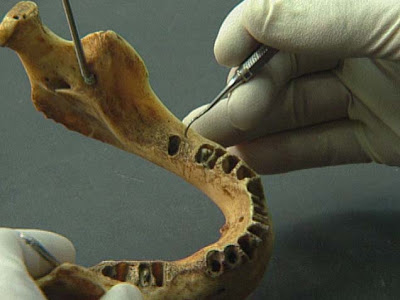
I heard about this story in a book I just reviewed which mentioned a collection of poems for kids by Connecticut’s Poet Laureate Marilyn Nelson (excerpt above). Fortune (c. 1740-1798) was the head of a family of 5 slaves - including his wife Dinah, their son Jacob (b. 1786), and their daughters Mira (b. 1789) and Roxa (b. 1791) - owned by Waterbury physician Dr. Preserved Porter. Fortune and family lived in their own house on the Porters' 75-acre farm, which produced rye, Indian corn, onions, potatoes, apples, beef, hogs, cider, hay, oats, and buckwheat. Fortune most likely managed the farm so that Dr. Porter could attend to his medical practice, and Dinah would have cleaned and cooked. A 19th c. source indicates that Fortune slipped on a rock, fell into the Naugatuck River, and drowned. After the accident, Dr. Porter prepared Fortune’s skeleton to use as a teaching aid in the anatomy classes he taught. Fortune's wife and his skeleton remained the property of the Porter family. When Dr. Porter died in 1804, Dinah was inherited by his widow and the skeleton was inherited by his son Jesse Porter, also a doctor. It passed on to generations of Porter physicians until donated to the Mattatuck Museum in 1933. Fortune’s
"We are brief incarnations,
we are clouds in clothes.
We are water respirators,
we are how earth knows.
I bore light passed on from an original flame;
while it was in my hands it was called by my name.
But I am not my body,
I am not my body."
 articulated bones were first placed on exhibit in the 1940s, contextualized within the history of medicine and slavery in Waterbury by the 1960s, and removed from display as the exhibit of human remains became politically sensitive in the 1970s.
articulated bones were first placed on exhibit in the 1940s, contextualized within the history of medicine and slavery in Waterbury by the 1960s, and removed from display as the exhibit of human remains became politically sensitive in the 1970s. In the 1990s, the Mattatuck Museum began to search for reliable evidence about Fortune's life and death. "Fortune lived in the doctor's household and was part of the family and was loved. But one day Fortune is at the Naugatuck River and he slips in and drowns. The story has it that Dr. Preserved Porter jumps in to save him, but can't. And so he flayed his body on the spot and took him home. Would you do that to the servant you love as part of the family?" asks anthropologist Dr. Warren Perry (2nd image). He and other anthropologists and archaeologists examined the skeleton, which belonged to a man of about 60 years of age in relatively good health. The rugged bone structure and muscle attachments suggested that Fortune was a powerful man accustomed to the heavy work of a farmer. Healed injuries indicated that he had broken his lower back and damaged the bones in his hands and feet, which would not have been unusual for an agricultural worker. A snapped vertebra points  to a cause of death by a sudden jerking back of the head, but there was no additional damage to suggest a hanging or a fall. In addition to the visual examination, the bones were measured and x-rayed (which offered probable height, age and illnesses), and DNA analysis (which may identify his descendants) and chemical analysis (which may determine where he grew up) were performed. A facial reconstruction prepared by forensic artist Frank Bender and a full-figure portrait (3rd image, cropped) painted by medical illustrator William Westwood have become the centerpiece of the museum’s exhibit about Fortune and the African-American community in Connecticut in the 18th c. Despite the value of the 200-year-old remains remaining above-ground and uncontaminated so that they will be available to researchers as future methods of analysis are developed, the question of whether to bury Fortune's skeleton has inevitably followed.
to a cause of death by a sudden jerking back of the head, but there was no additional damage to suggest a hanging or a fall. In addition to the visual examination, the bones were measured and x-rayed (which offered probable height, age and illnesses), and DNA analysis (which may identify his descendants) and chemical analysis (which may determine where he grew up) were performed. A facial reconstruction prepared by forensic artist Frank Bender and a full-figure portrait (3rd image, cropped) painted by medical illustrator William Westwood have become the centerpiece of the museum’s exhibit about Fortune and the African-American community in Connecticut in the 18th c. Despite the value of the 200-year-old remains remaining above-ground and uncontaminated so that they will be available to researchers as future methods of analysis are developed, the question of whether to bury Fortune's skeleton has inevitably followed.









No comments:
Post a Comment
You may add your comments here.